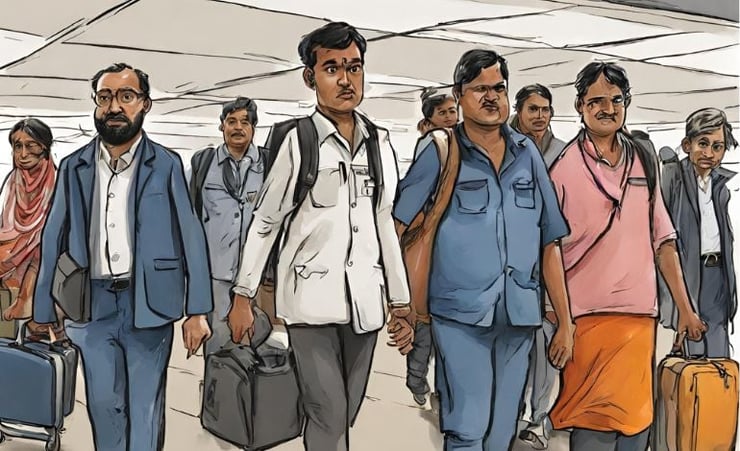NZ’s Record Migration Is Bad News For Indian Aspirants

More migrants arrived in New Zealand in 2023 than in any year in the history of the country. That number hasn’t gone down quietly among the political class.
Nearly 126,000 immigrants came to Aotearoa last year. Prime Minister Chris Luxon didn’t mince his words when he said the country cannot keep accommodating immigrants in such high numbers. He is already calling for greater scrutiny by immigration officials.
“Any immigration should be linked to the filling of skills shortages,” he said recently, adding, “The government would be working with Immigration New Zealand to make sure there were audits and checks in place to manage migrant numbers.”
So, what does it mean for Indians looking to make New Zealand their home? It does not bode well.
Indians led the pack of migrants who made their way to New Zealand last year. To be clear, such migrants have been the powerhouse of the country’s economy, filling critical blue-collar and white-collar jobs at a time when New Zealand was desperately short on workforce. But the numbers have begun to add up now.
About 60,000 non-New Zealand citizens were arriving on shore every year, on average, up until the Covid-19 pandemic hit. After a virtual stop on any immigration for nearly two years, the Labour government opened the floodgates to get the economy going after the pandemic.
Luxon now describes the visa settings as being “way too restrictive, to being way too loose, and we've gotta find that balance". He is not the only one sounding an alarm. The Reserve Bank's Monetary Policy Committee has warned the surge in migration poses threats to inflation by stoking demand in the economy.
Industry insiders say prospective immigrants are already beginning to see the repercussions of this record migration. Immigration advisers say over the last few months, officials have stepped up scrutiny not just while issuing work visas but also while evaluating applications from overseas students.
To add to that, the abuse of the country’s high-trust immigration model has only worsened the sentiment. The dozens of work visa holders found without a job onshore last year exposed a nexus of profiteers, including employers and agents, bringing in migrants who were proving a burden on the economy, not to mention the personal torture the victims endured.
The new government is already talking about firming up immigration settings, indicating increased awareness among policymakers that only those migrants that the country genuinely needs are allowed in.
It is not too hard to fathom what happens next, is it?
More migrants arrived in New Zealand in 2023 than in any year in the history of the country. That number hasn’t gone down quietly among the political class.
Nearly 126,000 immigrants came to Aotearoa last year. Prime Minister Chris Luxon didn’t mince his words when he said the country cannot keep...
More migrants arrived in New Zealand in 2023 than in any year in the history of the country. That number hasn’t gone down quietly among the political class.
Nearly 126,000 immigrants came to Aotearoa last year. Prime Minister Chris Luxon didn’t mince his words when he said the country cannot keep accommodating immigrants in such high numbers. He is already calling for greater scrutiny by immigration officials.
“Any immigration should be linked to the filling of skills shortages,” he said recently, adding, “The government would be working with Immigration New Zealand to make sure there were audits and checks in place to manage migrant numbers.”
So, what does it mean for Indians looking to make New Zealand their home? It does not bode well.
Indians led the pack of migrants who made their way to New Zealand last year. To be clear, such migrants have been the powerhouse of the country’s economy, filling critical blue-collar and white-collar jobs at a time when New Zealand was desperately short on workforce. But the numbers have begun to add up now.
About 60,000 non-New Zealand citizens were arriving on shore every year, on average, up until the Covid-19 pandemic hit. After a virtual stop on any immigration for nearly two years, the Labour government opened the floodgates to get the economy going after the pandemic.
Luxon now describes the visa settings as being “way too restrictive, to being way too loose, and we've gotta find that balance". He is not the only one sounding an alarm. The Reserve Bank's Monetary Policy Committee has warned the surge in migration poses threats to inflation by stoking demand in the economy.
Industry insiders say prospective immigrants are already beginning to see the repercussions of this record migration. Immigration advisers say over the last few months, officials have stepped up scrutiny not just while issuing work visas but also while evaluating applications from overseas students.
To add to that, the abuse of the country’s high-trust immigration model has only worsened the sentiment. The dozens of work visa holders found without a job onshore last year exposed a nexus of profiteers, including employers and agents, bringing in migrants who were proving a burden on the economy, not to mention the personal torture the victims endured.
The new government is already talking about firming up immigration settings, indicating increased awareness among policymakers that only those migrants that the country genuinely needs are allowed in.
It is not too hard to fathom what happens next, is it?









Leave a Comment